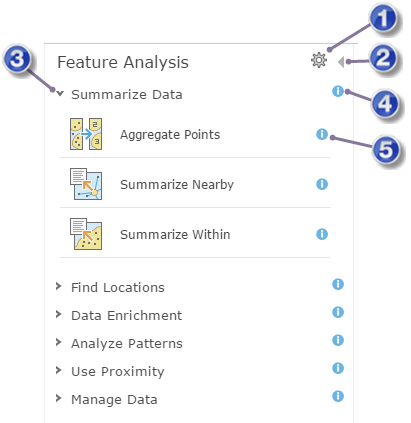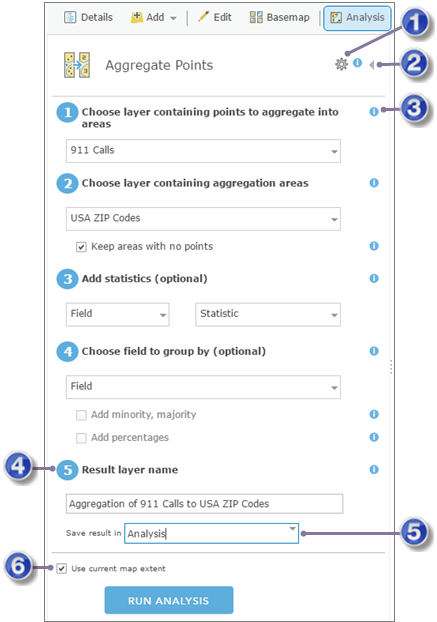Below you'll find information about accessing and using the analysis tools. This information applies to all tools.
Note:
This topic discusses the standard spatial analysis tools available in the portal. For information about the GeoAnalytics Tools, see Perform analysis using ArcGIS GeoAnalytics Server. See Understanding analysis in Portal for ArcGIS for an overview of each toolset.
License:
The administrator of your organization needs to grant you certain privileges for you to perform analysis. To use any of the analysis tools, you need the following privileges:
- Create, update, and delete content
- Publish hosted feature layers
- Spatial Analysis
If you do not have these privileges, you will not see the Perform Analysis option as described below.
Certain tools need additional privileges such as Network Analysis and GeoEnrichment. See Perform analysis for more information about these tools.
Access the tools
To access and use analysis tools in the map viewer, follow these steps:
- Open a web map containing the feature layer or layers you want to analyze in the map viewer.
- Click the Contents button in the Details pane.
- You can do one of the following:
- Click the Analysis button
 found on the map menu bar.
found on the map menu bar. - Alternatively, hover over the layer you want to analyze and click the Analysis button
 .
.
- Click the Analysis button
Both actions open the Perform Analysis pane.
Access the tools from the ArcGIS Python API
The ArcGIS Python API allows GIS analysts and data scientists to query, visualize, analyze, and transform their spatial data using the powerful analysis tools available in their organization. To learn more about the analysis capabilities of the API, see the documentation site.
The standard feature analysis tools can be accessed via the Features module.
Explore the Feature Analysis pane
The Feature Analysis pane is illustrated below. This pane contains a number of categories and each category contains tools. To view the tools within a category, click the expand or collapse button on the left side of the category.

 | Open the Analysis Environments dialog box |
 | Return to the Details pane. |
 | Expand the category to view tools within. |
 | View help about the category. |
 | View help for the tool. |
Note:
Analysis Environments are now available in Portal for ArcGIS to allow for GeoAnalytics Tools and Raster analysis, but can be used for Standard Tools as well. Processing Extent is the only environment that is used by Standard Tools. However, more environments will appear in the Analysis Environments pane if GeoAnalytics Tools and Raster analysis are enabled in your Portal.
Work with a tool pane
To open an analysis tool pane, click the tool icon. This opens the tool's pane as illustrated below with the Aggregate Points tool.

 | Open the Analysis Environments dialog box for the tool. |
 | Close the tool pane without running the analysis and return to the Perform Analysis pane. |
 | Get help about a parameter. |
 | The result of running the analysis is saved to My Content using this name. |
 | You can specify a folder in My Content in which to save the result. |
 | If checked, only the data visible in the current map will be analyzed. |
Note:
Analysis Environments can be set from the tool pane. Processing Extent is the only environment that is used by the Standard Tools. The Processing Extent applies to all tools, even when the extent is set from within a tool pane. The Use current map extent parameter will be unchecked when the Processing Extent is set. Checking Use current map extent will override the Processing Extent.
Each tool has a different set of parameters. You can always view help for a parameter by clicking the help icon next to the parameter as illustrated above. All tools have a Result layer name parameter where the results of running the analysis are written. You can change this name or use the default value.
Use current map extent
It is recommended that you always check Use current map extent and that you zoom in to the area you want analyzed. Doing so limits the number of features the tool needs to examine when performing analysis. It also limits the number of credits that may be used by the tool if it is configured to use utility services from ArcGIS Online. If you uncheck Use current map extent, all features in the analysis layer will potentially be analyzed, and credits used by the tool will be based on the number of features in the layer.
Layers and data you can analyze
Note:
Some tools only work on certain kinds of feature types; for example, Aggregate Points requires an input layer containing point features.
You have the following options when choosing a layer to analyze:
- Choose a layer from your map.
- Browse Layers to choose any layer in the portal to which you have access. Use this option if you want to access feature layers that contain more than one layer, such as the Esri boundary layers, as the Browse Layers dialog box allows you to choose an individual layer within the feature layer. If you do not choose an individual layer when running analysis, the tool uses the first layer it encounters.
- Choose Living Atlas Analysis Layer or Choose Analysis Layer to view and select a layer from a preconfigured analysis group. If the portal administrator has configured the portal to access Living Atlas analysis layers, you will see the first option. If the portal administrator has configured the portal to access layers from a custom group, you will see the second option.
Tip:
Use an asterisk (*) as a wild card when searching for content in the Choose Living Atlas Analysis Layer or Choose Analysis Layer dialog box. For example, if you are looking for layers with Australia in their title, search for Aus*.
You can perform analysis on the following types of layers and data:
- Feature
service
The portal must be able to access the feature service; therefore, the URL to the service must either be publically accessible or within the same network as the portal and hosting server you use to run the analysis. You cannot perform analysis on layers based on nonaccessible feature services.
- Map service
As with feature services, the map service must be publically accessible or within the same network as the analyzing portal and hosting server.
- Hosted feature layers
- Hosted WFS layers
- Hosted tile layers
The layer must have the query capability enabled.
- Comma-separated values (CSV) file (.csv)
- KML layers
- GPS exchange format file (.gpx)
- Shapefile (.zip)
- GeoRSS web feed
- Map notes
- Route layers
- WFS layers
Analysis output
Most analysis tools run in the map viewer create hosted feature layers as output. These output layers are projected in the spatial reference of the input layer.